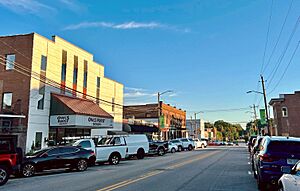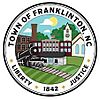Franklinton, North Carolina facts for kids
Quick facts for kids
Franklinton, North Carolina
|
||
|---|---|---|

Downtown Franklinton
|
||
|
||
| Motto(s):
Small Town, Home Town, Your Town
|
||

Location of Franklinton, North Carolina
|
||
| Country | United States | |
| State | North Carolina | |
| County | Franklin | |
| Established | 1839 | |
| Incorporated | December 20, 1842 | |
| Named for | Benjamin Franklin | |
| Government | ||
| • Type | Board of Commissioners | |
| Area | ||
| • Total | 2.41 sq mi (4.52 km2) | |
| • Land | 2.40 sq mi (4.50 km2) | |
| • Water | 0.01 sq mi (0.02 km2) | |
| Elevation | 404 ft (123 m) | |
| Population
(2020)
|
||
| • Total | 2,456 | |
| • Density | 1,413.93/sq mi (545.81/km2) | |
| Time zone | UTC-5 (Eastern (EST)) | |
| • Summer (DST) | UTC-4 (EDT) | |
| ZIP code |
27525
|
|
| Area code(s) | 919 and 984 | |
| FIPS code | 37-24720 | |
| GNIS feature ID | 2406521 | |
| Website | https://www.franklintonnc.us | |
Franklinton is a small town in Franklin County, North Carolina, United States. It's a friendly place with a motto that says, "Small Town, Home Town, Your Town." In 2020, about 2,456 people lived there. The town was named after the famous Benjamin Franklin.
Contents
History of Franklinton
Franklinton started as Franklin Depot in 1839. It was built on land owned by Shemuel Kearney. His family had lived in the area for a long time. Their home, built in 1759, is one of the oldest houses in Franklin County. In 1842, Franklin Depot officially became a town and changed its name to Franklinton.
Early Education and Industry
In the late 1800s, there was a chance for Trinity College (now Duke University) to move to Franklinton. However, it ended up moving to Durham instead.
Franklinton was home to Albion Academy, a school for African-American students. It opened in 1879. This school helped many students learn and grow. Later, it combined with another school and eventually became Franklinton Elementary School. In 1969, schools became fully integrated. Mary Little was the first African-American teacher at the newly integrated Franklinton High School.
The Sterling Cotton Mill was an important factory in Franklinton. It opened in 1895 and made fabric products for many years. The mill closed in 1991. Today, it is recognized as a historic place. Another textile factory, Vamoco Mills, also operated here but closed in 1989.
Important Events and People
In December 1919, a sad event happened in Franklinton. A World War I veteran named Powell Green was involved in an argument. He was later taken by a group of people and killed. This was a terrible act of injustice.
A famous boxer, Jack Johnson, died in a car crash in Franklinton in 1946. This happened on U.S. Highway 1.
Franklinton has faced large wildfires. In 1963, a fire burned about 9,500 acres (38 km2) of land. Another fire in 2008 covered about 1,000 acres (4 km2). Firefighters worked hard to control these fires.
From 1996 to 2012, Franklinton had a private school called Opio Holy Spirit Academy. It helped students with different learning needs.
The town has had several mayors. Charles Draughn III was mayor for eight years, followed by Larry Kearney, Jenny McGhee Edwards, and Elic Senter. The current mayor, Art Wright, was elected in 2015.
Since 1985, Franklinton has been a Tree City USA community. This means the town works to plant and care for trees.
Many historic buildings in Franklinton are listed on the National Register of Historic Places. These include the Franklinton Depot, Dr. J. H. Harris House, and the Sterling Cotton Mill. These places are privately owned and should be respected.
Geography of Franklinton
Franklinton covers about 1.6 square miles (4.1 km2) of land. The center of town is where Main Street (U.S. Highway 1A) and Mason Street meet. U.S. Highway 1 goes around the west side of town.
Franklinton is about 30 miles (48 km) northeast of Raleigh. The Tar River is just 4 miles (6 km) south of the town.
A railway line, operated by CSX Transportation, runs through Franklinton. This line was once part of the old Seaboard Coast Line Railroad. There was also a smaller train line that went from Franklinton to Louisburg, but its tracks were removed years ago.
Population and People
| Historical population | |||
|---|---|---|---|
| Census | Pop. | %± | |
| 1860 | 160 | — | |
| 1870 | 305 | 90.6% | |
| 1880 | 484 | 58.7% | |
| 1890 | 583 | 20.5% | |
| 1900 | 761 | 30.5% | |
| 1910 | 809 | 6.3% | |
| 1920 | 1,058 | 30.8% | |
| 1930 | 1,320 | 24.8% | |
| 1940 | 1,273 | −3.6% | |
| 1950 | 1,414 | 11.1% | |
| 1960 | 1,513 | 7.0% | |
| 1970 | 1,459 | −3.6% | |
| 1980 | 1,394 | −4.5% | |
| 1990 | 1,615 | 15.9% | |
| 2000 | 1,745 | 8.0% | |
| 2010 | 2,023 | 15.9% | |
| 2020 | 2,456 | 21.4% | |
| U.S. Decennial Census | |||
How Many People Live Here?
The population of Franklinton has grown over the years. In 2020, there were 2,456 people living in the town. There were 883 households, which are groups of people living together in homes.
Who Lives in Franklinton?
Franklinton is a diverse town. The 2020 United States census showed that:
| Race | Number | Percentage |
|---|---|---|
| White (non-Hispanic) | 1,121 | 45.64% |
| Black or African American (non-Hispanic) | 1,012 | 41.21% |
| Native American | 6 | 0.24% |
| Asian | 22 | 0.9% |
| Other/Mixed | 129 | 5.25% |
| Hispanic or Latino | 166 | 6.76% |
In 2010, about 55.8% of the people were White, and 40.8% were African American. About 4.1% of the population was Hispanic or Latino.
The town has people of all ages. In 2010, about 25.7% of the population was under 20 years old. About 19.8% were 65 years or older.
Notable People from Franklinton
Many interesting people have come from Franklinton, including:
- Henry Bibby, a basketball player and coach in the NBA.
- Jim Bibby, a baseball player and Henry's brother.
- Wilbur Wade Card, a baseball player and the first basketball coach at Duke University.
- Jason Michael Carroll, a Country music singer.
- Thomas O. Fuller, a state senator.
- Moses A. Hopkins, a diplomat, clergyman, and educator.
- Abby House, known for supporting Confederate soldiers.
- Wilmont Perry, an NFL Football Player.
- Soupy Sales, a comedian.
- Gene Wooten, a bluegrass musician.
See also
 In Spanish: Franklinton (Carolina del Norte) para niños
In Spanish: Franklinton (Carolina del Norte) para niños


